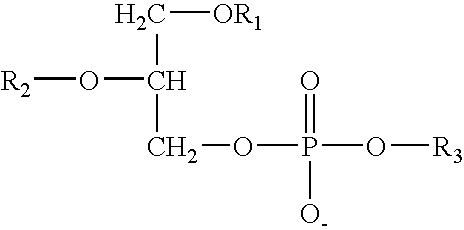Method and composition for solubilising a biologically active compound with low water solubilty
a biologically active compound and low water solubility technology, applied in the direction of organic active ingredients, non-active ingredients of pharmaceuticals, oil/fat/waxes non-active ingredients, etc., can solve the problems of poor aqueous solubility of compounds, poor lipophilic solubility, capillary blockage, etc., to avoid stability and storage problems, reduce the release rate of drugs from liposomes, and eliminate stability problems.
- Summary
- Abstract
- Description
- Claims
- Application Information
AI Technical Summary
Benefits of technology
Problems solved by technology
Method used
Image
Examples
example 1
[0051]10 mg of miconazole and 1 mg of POPG are dissolved in 0.25 g of ethanol and held in a vial. 2.5 g of a 10% phospholipid (98% soya phosphatidylcholine and 2% egg PG) mixture is obtained and hydrated in 10 ml distilled water. The lipid dispersion is passed through a high pressure homogeniser (Emulsiflex C5, Avestin) to obtain an optically clear suspension. The lipid particles are smaller than 100 nm. The content of the first vial is added to the clear lipid dispersion in the second vial and shaken. The resulting dispersion of molecular associates is clear and there is no decrease in the light transmission. Over 90% of the miconozole is transferred to the lipid particles and may be confirmed by analytical filtration and HPLC analysis. The lipid suspension may be administered by inhalation using a nebuliser or it may be applied topically.
example 2
[0052]10 mg of triclabendazole and 5 mg of sodium oleate are dissolved in 0.5 ml ethanol in a first container with 5 ml of deionised water containing 50 mg of lactose. In place of sodium oleate a bile salt or a charged membrane lipid may be used. The resultant dispersion is immediately frozen and lyophophilised to produce a cake. To this cake 2.5 g of a 10% phospholipid dispersion (98% egg PC) produced by high pressure homogenisation is added. The appearance of the dispersion remains clear after the addition to the cake. The decrease in light transmission is less than 10%.
example 3
[0053]An antiviral compound C23H21N5SF active with low water solubility (0.00008 g / l), melting point 179° C. is associated with lipid particles as follows:
[0054]25 mg of the antiviral compound is dissolved in 975 mg of PEG400 / ethanol (1:1 v / v) containing PG (2.5 mg / ml) and held in a first vial.
[0055]A 12% w / w phospholipid suspension as in Example 1 is prepared by dispersing the lipid in 2.5% w / w glycerol at room temperature, followed by passage through an Avestin high pressure homogeniser. The mean particle size of the lipid particles as measured by photon correlation spectroscopy is ca. 40 nm. This is held in a second vial.
[0056]Instant partition loading of the antiviral compound according to the invention is performed under aseptic conditions by adding 0.4 ml of the organic drug solution in the first vial to 10 ml of lipid particles in the second vial while gently swirling the vial. The resulting lipid suspension has a particle size of 54 nm and is free from precipitated drug part...
PUM
| Property | Measurement | Unit |
|---|---|---|
| Fraction | aaaaa | aaaaa |
| Fraction | aaaaa | aaaaa |
| Fraction | aaaaa | aaaaa |
Abstract
Description
Claims
Application Information
 Login to View More
Login to View More - R&D Engineer
- R&D Manager
- IP Professional
- Industry Leading Data Capabilities
- Powerful AI technology
- Patent DNA Extraction
Browse by: Latest US Patents, China's latest patents, Technical Efficacy Thesaurus, Application Domain, Technology Topic, Popular Technical Reports.
© 2024 PatSnap. All rights reserved.Legal|Privacy policy|Modern Slavery Act Transparency Statement|Sitemap|About US| Contact US: help@patsnap.com









